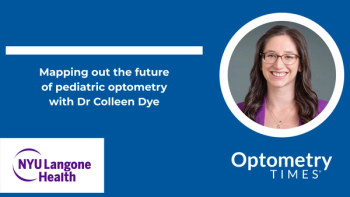
- September/October digital edition 2025
- Volume 17
- Issue 05
The future of optometry: Dr Rachelle Lin taking the low vision world by storm
Rachelle Lin, OD, MS, FAAO, has refined her passions for academia, teaching, low vision practice, and advocacy work to build out a well-rounded career.
Although she commits to a lot of everything – from lectures and teaching to advocacy work and low vision practice – Rachelle Lin, OD, MS, FAAO, finds the most value in knowing that she can provide quality care for her patients.
“My career has consistently surprised me,” Lin said. “At the moment, the things that I’m very passion about are genetic testing, working with patients with inherited retinal disease, and getting the word out about how genetic testing can help these patients, for many reasons. It’s been a pleasure lecturing locally and nationally to optometrists, but also to ophthalmologists who work hand in hand with us about how we can implement both the genetic testing and low vision rehabilitation for patients with inherited eye diseases.”
Currently an associate professor at her alma mater, the Southern California College of Optometry (SCCO) at Marshall B. Ketchum University (MBKU), Lin also treats patients in the clinical departments of Low Vision Rehabilitation and Acquired Brain Injury at the University Eye Center at Ketchum Health in Anaheim, California. Her colleagues also agree that she shines particularly in the areas of education and patient care.
“The words that come to mind when I think of Dr Lin – dedicated and passionate to advancing patient care, diligent in all her initiatives, and persistent in getting things accomplished,” said John H Nishimoto, OD, MBA, FAAO, professor and senior associate dean for Professional Affairs and Clinical Education at MBKU, who works with Lin in clinical education and training the schools’ interns. “She is also most collegial and humble with anyone she meets.”
“Dr Lin is incredibly dedicated to the profession of optometry,” said Annabelle Storch, OD, who practices at UCI Health in Irvine and Orange, California. “We have worked together the last few years primarily through our involvement with our local optometric society, Orange County Optometric Society (OCOS), and she is someone I know I can count on. She is hardworking and knowledgeable. She is not afraid to put the necessary time in to make something the best it can be.”
California made
Having grown up in Southern California, Lin stayed close to her roots by attending University of California Irvine, graduating with a Bachelor’s degree in 2009. “I didn’t know I wanted to go into optometry until very late,” she said. “I was actually headed the medical route. I was working with some amazing doctors who are very passionate about their specific field of medicine, and I figured I should find a part that I was really passionate about.”
After shadowing some optometrists in the area, Lin said the draw to the profession for her was having the opportunity to get to know patients more in depth by means of consistent visits over several years. This was particularly prevalent in her work with patients with low vision, which she delved into during her fourth year at SCCO, as well as during her year-long residency at the Tibor Rubin VA Medical Center in Long Beach, California, which she began after graduating optometry school in 2013.
“It allows me to ask them what their goals are, and how cool is that? I get to hear people’s dreams and hopefully do as much as I can to help them achieve those goals,” Lin said. She added that during her residency, she worked in conjunction with ophthalmologists and occupational therapists to provide comprehensive care for veterans.
Academic rigor
Another reason why Lin chose to complete a residency was her interest in academia, in addition to low vision practice. By completing a joint Doctor of Optometry and Master of Science in Vision Science program, Lin said that she figured that completing a residency program would improve her chance of landing a position with a school or college of optometry.
And she was right. In 2014, a spot on SCCO’s faculty in the low vision clinic opened up when Lin had finished her residency. “It was the perfect match,” she said. Lin currently teaches genetics to first-year students, low vision to third-year students, and precepts the fourth-year students while on rotation in the low vision clinic. In 2024, she received the 2023 COA Educator of the Year award.
Nishimoto said that Lin has proven integral to the schools’ international optometry programs. “She currently has the academic rank of associate professor, which speaks volumes of her professional accomplishments,” he said, noting that Lin also lectures in the areas of low vision rehabilitation, traumatic brain injury, and genetics, in addition to publishing in peer-reviewed journals.
Lin said that her approach to education is to arm students with the ability to adapt to new technology as it develops. “All educators in optometry want to make sure that all of our graduates are prepared to deliver the best possible care for patients, not just based off of the knowledge and technologies that we have today, but prepare them for being able to adapt to the future of medicine as it evolves and it grows,” Lin said.
Advocacy work
Advocacy was another facet of Lin’s career that she did not initially anticipate. Although she did not get involved in advocacy efforts until after she graduated optometry school, Lin is now serving on the California Optometric Association (COA) Board of Trustees as president-elect. She previously served as the chair of the COA Low Vision Rehabilitation Section, and the president of the Orange County Optometric Society.
“Most notably, Dr Lin possesses leadership skills that are never polarizing, which is a major reason she is President Elect of the California Optometric Association,” Nishimoto said. “Her ascension to lead the profession is nothing short of amazing.”
Storch stated that she recently asked Lin to serve as a keyperson for her federal legislator. Despite having only starting the position a handful of months ago, “…she has already taken the time to attend multiple events hosted by the legislator and introduce herself,” Storch said. “We know that these personal connections matter and Dr Lin has not questioned what she needs to do to make herself the legislator's expert on eye care related topics.”
“I realized that it’s so important that we are advocating for the profession as well as for our patients, because what we do and how we practice is legislated by the state,” Lin said. “We’re, as a university, always pushing the best technologies and the future technologies, and teaching at the highest scope that’s available in any state in the country, because our graduates can go to practice in any state …. In realizing that advocacy is super important for the profession and for patients, I just felt like it was something I had to contribute.”
Ultimately, Lin said that her work with patients with low vision and optometric advocacy are often intertwined due to specific challenges that they face, such as difficulty with access to treatments and low vision resources. “Patients tell us all the time how they wish that they’d come in sooner or they wish that they had known that they were able to get devices and services through the state,” Lin said.
Ultimately, it is this passion for low vision rehabilitation and patient care that drives all aspects of Lin’s career.
“Low vision rehab is just a really awesome [field to work in],” she said. “There’s a lot of need in low vision rehabilitation, and we know that the patient population, unfortunately, is just going to keep growing with the aging population, as well as just the prevalence of diabetic retinopathy, age-related macular degeneration, glaucoma, and more. Of course we can hope that science progresses and medicine progresses and we find treatments for all these things, but we’re not at that point yet where we’re eliminating these diseases.
“So low vision rehab is just such a fulfilling career, as is teaching. I get the best of both worlds, and I’m really appreciative for this profession and the opportunities that have come along the way.”
Articles in this issue
about 1 month ago
What a pharmaceutical representative taught me about glaucoma dropsabout 1 month ago
AI glasses fill in gaps for patients with low visionNewsletter
Want more insights like this? Subscribe to Optometry Times and get clinical pearls and practice tips delivered straight to your inbox.



















































.png)


